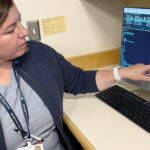Scoliosis bracing: How to support your child

Q&A with M. Timothy Hresko, MD and Deborah Cranford, RN
Most patients with idiopathic scoliosis will never need a brace, and even fewer will need surgery. But those who do need to wear a brace, need to follow the protocol as closely as possible.
Here, Dr. Timothy Hresko, an orthopedic surgeon in the Spine Division and Deborah Cranford, a nurse at Boston Children’s who works closely with scoliosis patients, offer tips for parents whose children have been prescribed a brace for scoliosis.
What should parents expect when their child first starts wearing a scoliosis brace?
Cranford: When a patient first gets a brace, they’ll meet with me or another nurse in the Spine Division. We’ll go over brace wearing with them, how to care for their brace, and how to care for their skin. We’ll also go over their schedule and help them plan ways to stay involved in sports and other activities while wearing their brace for the number of hours a day their doctor prescribed.
Wearing a brace is often a process of trial and error at first, as the patient and family figure out what’s normal. It’s normal for a brace to be uncomfortable for the first couple of weeks, but the brace shouldn’t hurt. If it does, the family probably needs to go back to the orthotist to have it adjusted. Also, the patient’s skin should not be red or blistering. If it is, we’ll work on that.
How do you decide how many hours a day a patient should wear their brace?
Dr. Hresko: The number of hours a day depends on the patient’s curve and stage of growth. For patients with adolescent idiopathic scoliosis, the most important time to wear their brace is when they are going through periods of rapid growth. This is when an existing curve is at the highest risk of becoming more severe.
It’s clear the more you wear the brace, the more effective it is. So, if you cut back on the hours of the day you wear it, you’re going to lose some of your chance of success. This will increase the chance you’ll need surgery at some point.
How do parents know if their child is wearing their brace enough?
Dr. Hresko: I used to hear arguments about this all the time. The parent would tell me their child was never wearing their brace and the child would say, “I’m wearing it all the time, you just don’t see me wearing it.”
Now braces come with monitors that show exactly how many hours a day the patient is wearing their brace. We don’t do this to punish kids, but if we know they are struggling, we can work with them on strategies to wear their brace more.
How can parents motivate their children to wear their brace?
Cranford: Bracing is a family affair. Every member of the family should be on the same page with regards to the number of hours the brace needs to be worn and how brace wear fits into the child’s schedule. Children quite often are very busy with extracurricular activities, sometimes leaving little wiggle room for time they can spend out of the brace.
Parents should be very cognizant of their child’s schedule, and help them balance the time in the brace and time out of the brace so they can do the things they like to do. In addition, parents should make an extra effort to understand the social stressors their child is facing, particularly in adolescents. A teen or tween may feel self-conscious in ways that don’t make sense to the parent. The best thing the parent can do in circumstances like this is give their child room for their feelings while still maintaining the importance of wearing the brace.
How can a kid balance the demands of school and other activities with the demands of brace wearing?
Cranford: We encourage patients to arrange their schedules so they can take off their brace when they’re doing sports or other activities. We recently had a patient who is a professional dancer. Her practice schedule had her dancing between four and six hours a day after school. Not surprisingly, it was a struggle to get in her brace-wearing time, especially because she was also taking gym at school. We worked with her family and came to the decision to keep her out of gym for the remainder of the school year. This allowed her to dance while also completing her bracing. Ultimately, we really don’t want to inhibit activities that are good for a child’s well-being and self-confidence.
Do you have any advice to help kids feel more comfortable in their bodies while wearing a brace?
Cranford: I think it really helps to take ownership of the brace by learning to put it on and take it off independently. When our patients reach this milestone and no longer have to rely on other people to help them with their brace, it seems to empower them.
If they feel comfortable doing so, it’s often helpful to tell friends about the brace. Some kids put so much effort put into trying meticulously to hide their brace, it’s a huge relief when it is finally out in the open.
Also, I’ve seen some kids have fun with fashion and layering clothes over their brace. As with any kid, it’s a great idea to wear clothes that are comfortable and make them feel good.
Is there any way to help make the brace more comfortable?
Dr. Hresko: Many of our patients tell us that the brace is more comfortable in cooler environments. In the summer, parents can look for ways for their child to spend time in air-conditioned places, whether at home, the library, or movies.
What resources does Boston Children’s offer for kids who need to wear a scoliosis brace?
Dr. Hresko: Our Spine Division developed a slideshow called Embrace the Brace. It includes photos of patients in their braces and advice from the patients and their physicians for taking charge of their brace wearing.
You will probably need to help your child get in and out of the brace at first. We have video describing how to put on a Boston Brace. Over time, many of our patients get good at putting the brace on and taking it off on their own.
Learn more about the Boston Children’s Spine Division.
Related Posts :
-

Ask a sports medicine specialist: Why are ACL tears so common among female athletes?
When an athlete is sprinting after an opponent who suddenly stops or changes direction, their anterior cruciate ligaments (ACLs) make ...
-

Forging a path back to school after orthopedic trauma
Orthopedic trauma can force children to miss school, sometimes for an extended period. But even when patients have regained enough ...
-

Jackie’s dreams of playing professional soccer back on track after ACL surgery
From her dorm in Newcastle, England, Jackie Zapata can hear fans roaring in the soccer stadium a few blocks away. ...
-

What orthopedic trauma surgeons wish more parents knew about lawnmower injuries
Summer is full of delights: lemonade, ice cream, and fresh-cut grass to name a few. Unfortunately, the warmer months can ...





